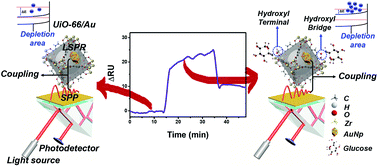Performance enhancement strategies for surface plasmon resonance sensors in direct glucose detection using pristine and modified UiO-66: effects of morphology, immobilization technique, and signal amplification†
Abstract
Diabetes is a dangerous disease caused by the inability of the body to produce and use insulin properly, resulting in an increase in the blood glucose level. The most advanced technology for glucose detection is the surface plasmon resonance (SPR)-based sensor. However, this technology has a slight drawback due to the small size of glucose. As a porous material, Zr-based UiO-66 MOF has good adsorption with glucose via hydrogen bonding, so it can be utilized as a receptor and active layer for the SPR glucose sensor, without the need for other receptors, such as glucose oxidase, concanavalin A, or boronic acid-based compounds. This study investigates the morphology effect, immobilization techniques, and signal amplification strategies for optimizing the utilization of UiO-66 in the SPR glucose sensor. By optimizing these parameters, a high-performance SPR glucose sensor with a detection limit of 0.0693 mM (S/N = 3) in the concentration range of 0.01–10 mM is successfully developed. In addition, a selectivity test reveals that the UiO-66/Au-based SPR sensor exhibits a high selectivity toward glucose. Furthermore, the developed SPR sensor showed a good ability in detecting glucose in human blood serum, suggesting its promising potential for practical applications.



 Please wait while we load your content...
Please wait while we load your content...